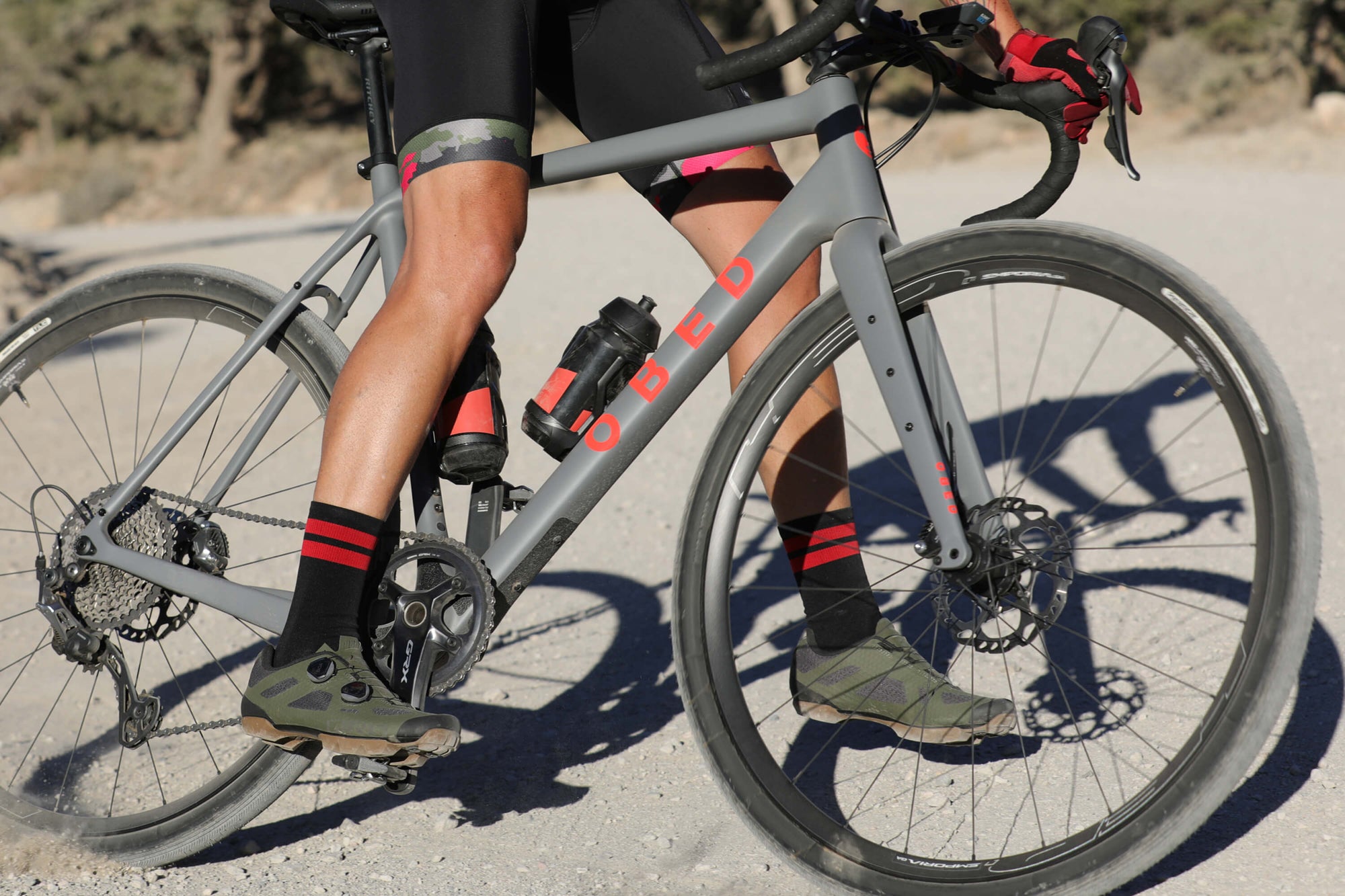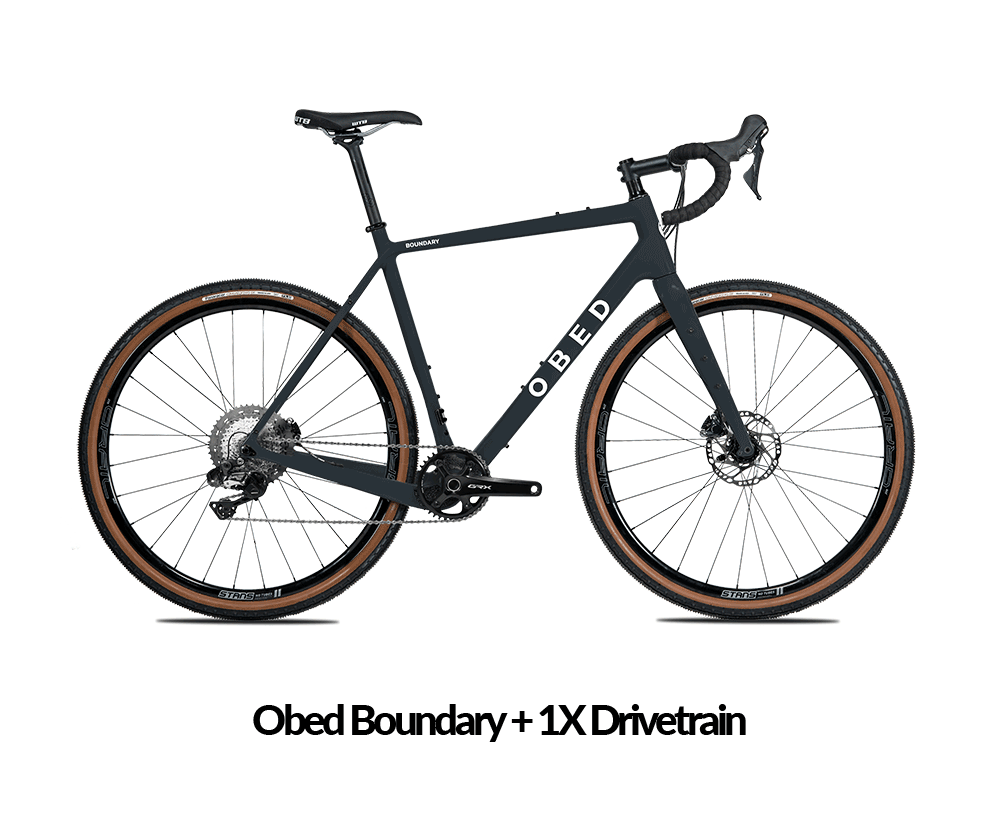
1x vs. 2x Gravel Bike Drivetrains
What is best for you: 1x vs. 2x gravel bike drivetrain?

Your drivetrain choice is probably one of the biggest decisions when building your OBED gravel bike. You may be wondering: What’s the difference between a 1x (one-by) or 2x (two-by) drivetrain? And ultimately, which should you choose?
Let’s answer the first question: What is 1x and 2x?
1x or 2x refers to the number of front chainrings—a 1x has a single front chainring, while 2x has two (along with a front derailleur). When gravel cycling became a cycling segment in its own right, it brought together technology from two separate cycling disciplines: road and mountain biking. The result is a drop bar bike made to be ridden on paved and unpaved roads, as well as trails. And those trails can vary from groomed fireroad to, for some, steep, rocky singletrack.
That brought forth the option of two different types of drivetrains; 2x road bike-style drivetrains that provide tighter jumps between gears across the gear range to help maintain a rider’s ideal cadence, and 1x mountain bike-style gearing, with big gear jumps and a wide gear range to get up steep climbs at low speed.
Both modern 1x and 2x gravel-specific drivetrains can handle bumpy terrain with clutched rear derailleur offerings from Shimano and SRAM (which takes the bounce out of the rear derailleur’s lower jockey and reduces chain slap and the chance of dropped bicycle chains on even the bumpiest trails). You’ll find clutched rear derailleurs in Shimano’s GRX range, and SRAM’s entire mechanical and AXS 1x range. Be sure to consider this feature when choosing your drivetrain.
OBED gravel bikes can be built to run either road-style 2x gearing, or mountain bike-like 1x gearing.
So…which drivetrain should you choose? It may depend upon how you ride, and often, where you ride. Let’s look at different case use situations, which will hopefully help you determine the best choice for you.

Choose a 2x gravel bike drivetrain if...
You ride your gravel bike a lot like a road bike. 2x provides smaller jumps between gears that require only slight cadence changes. Smaller steps between gears will help keep you pedaling at your ideal cadence whether you’re riding flat roads, over rollers, up big climbs, or down steep descents. Those that find themselves on more pavement or riding in hillier terrain may prefer 2x for the more road-like shifting experience.
You ride (and race) at high speeds. Are you trying to compete with yourself or against other fast riders? Do you regularly ride at or above your threshold to stay attached to fast groups? Those minimized jumps between gears will be much less jarring on a 2x drivetrain, keeping your power much steadier as your ride “on the rivet.”
You want to be able to climb (and descend) everything. Generally speaking, a 2x drivetrain will have capacity for a wider gear range. That is, its climbing gears will make for easier climbing, and its descending gears will make for less of a “spun out” experience on a steep, fast descent. With fewer gears, 1x tends to sacrifice a bit at the ends of the gear range.
Choose a 1x gravel bike drivetrain if...
You ride your gravel bike a lot like a mountain bike. Many of today’s modern mountain bikes are running 1x. That means those MTB’ers used to riding chunky, rocky singletrack on their mountain bikes are familiar with 1x gearing changes, i.e. larger cadence changes when moving between gears. They probably already like the simplicity and chain security, and it will suit the singletrack trails where experienced mountain bikers shine a bit better. Sticking with 1x will make going to a gravel bike a seamless transfer.
Weight savings is a premium for you. Want to build a climbing machine as light as you can? A 1x drivetrain—with just one front single chainring and no front derailleur—will save you well over 200 grams; not a game-changer, but hey, some of us just wanna cut weight on a bike; a 1x drivetrain is a simple place to start.
Simplicity reigns. Without a front derailleur, a 1x front ring has narrow-wide chainring teeth to keep the chain wrap super secure over the biggest bumps on the trail. And with that front derailleur being absent, that’s also one less piece of equipment to require adjustment or wear out.
You’re new to gravel riding. With just shifting of the rear derailleur to worry about, shifting a 1x drivetrain is easier for beginners to understand and operate.
You ride in inclement weather. Again, less mechanical pieces means fewer things to foul up, particularly when the mud turns into peanut butter.
Still unsure? Our OBED in-house team is ready to LiveChat about a wide range of gear choices when looking at how to build your Boundary or GVR. Just visit the website, click the pop-up box, and ask our team of experts (many of whom are out sharing the same trails with you) what they think might be your best bet.